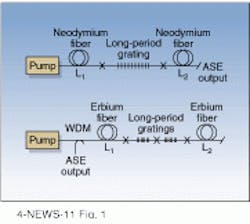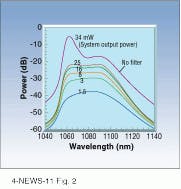OPTICAL AMPLIFIERS: Long-period gratings flatten fiber-amplifier gain
Specially tailored long-period fiber gratings can flatten the gain profile of rare-earth-doped fiber amplifiers yielding broadband sources with high output power that are attractive for wavelength-division-multiplexing applications and biomedical imaging. The work was reported by researchers Craig Hodgson of Stanford University (Stanford, CA) and Ashish Vengsarkar of Lucent Technologies (Murray Hill, NJ) at OFC '96 (paper #TUG3; San Jose, CA).
At low powers, amplified spontaneous emission (ASE) from rare-earth-doped fibers can produce broadband output, but this bandwidth narrows as output powers increase. Long-period fiber gratings inserted in an ASE source can broaden source output by removing peaks from the output spectrum before gain saturation can occur. The gratings act as wavelength-dependent loss elements, or filters, eliminating unwanted features in the gain spectrum of the amplifier. Though gain flattening is the most obvious application, the filters could be used to create any custom spectral shape.
These filters offer an economical alternative to blazed Bragg gratings, which also can be used for gain conditioning. Because long-period gratings involve periodicities on the order of 200 µm, they can be produced with simple chrome-on-glass amplitude masks, instead of the more-complex phase masks required for Bragg-grating fabrication. Spectral width of the filter varies as the inverse of the grating length; the longer the grating, the narrower the filter. Lengths of the components range between 10 and 60 mm.
Grating design and fabrication
An initial demonstration by Hodgson and Vengsarkar involved a 380-cm-long neodymium-doped fiber amplifier with a 150-mW gallium aluminum arsenide diode laser copropagating pump source at 822 nm. The unconditioned output spectrum was 7 nm at FWHM and included a 10-dB peak near 1060 nm with a 2.2-dB/nm spectral slope between 1060 and 1100 nm (see Fig. 1). Peak output power was 34 mW.
To remove the high slope regions, Hodgson and Vengsarkar chose commercially available single-mode silica fiber with a cutoff wavelength of 950 nm. Hodgson wrote an 11-mm-long grating into the silica fiber with a periodicity of 210 µm and spliced it in the ASE fiber at 145 cm. The location of the grating affects the performance of the source. If the grating is too close to the source, the filter couples a large amount of power out of the fiber. If the grating is too far from the source, the filter is ineffective. In this case, grating positions were determined iteratively; computer modeling should help with this in the future. Grating peak coupling to the cladding mode at 1062 nm matched the gain peak of the neodymium-doped fiber.
Output power for the completed system was reduced to 25 mW, but the spectral profile was significantly improved. Maximum slope dropped to 0.1 dB/nm, FWHM spectral width rose to 40 nm, centered at 1080 nm, and the coherence length was 12 µm (see Fig. 2). The filtered source maintained this performance for source powers ranging from 1.5 to 25 mW. Output-power reduction was attributed to filtering and splicing losses. Long-period gratings were also added to a 20-m-long erbium-doped fiber amplifier with a 23-mW counterpropagating diode-laser pump source operating at 1480 nm. Output from the unfiltered source showed a FWHM of 19 nm with 6.2-dB ripple occurring between 1530 and 1565 nm. Peak output power was 8 mW.Gain correction in this case required two separate silica-fiber gratings. The first was 60 mm long with a 408-µm period and a peak coupling to cladding mode at 1531 nm, matching the gain peak of the erbium fiber. The second grating, 26 mm long, had a grating periodicity of 398 µm; peak coupling to cladding occurred at 1556 nm. The two components were spliced into the amplifier in series, 10 m along the fiber. Preliminary efforts reduced ripple in the output spectrum, yielding a maximum ripple of 1.7 dB. Output from the filtered erbium-doped amplifier was at 7.3 mW with a FWHM of 38 nm.
Such filtered sources are finding practical applications. Eric Swanson of the Massachusetts Institute of Technology Lincoln Laboratory (Lexington, MA) is now using the neodymium-doped source for biomedical imaging research. With the addition of the fiber gratings, the source offers higher power and broader output spectrum than alternate sources such as superluminescent diodes.
About the Author
Kristin Lewotsky
Associate Editor (1994-1997)
Kristin Lewotsky was an associate editor for Laser Focus World from December 1994 through November 1997.

